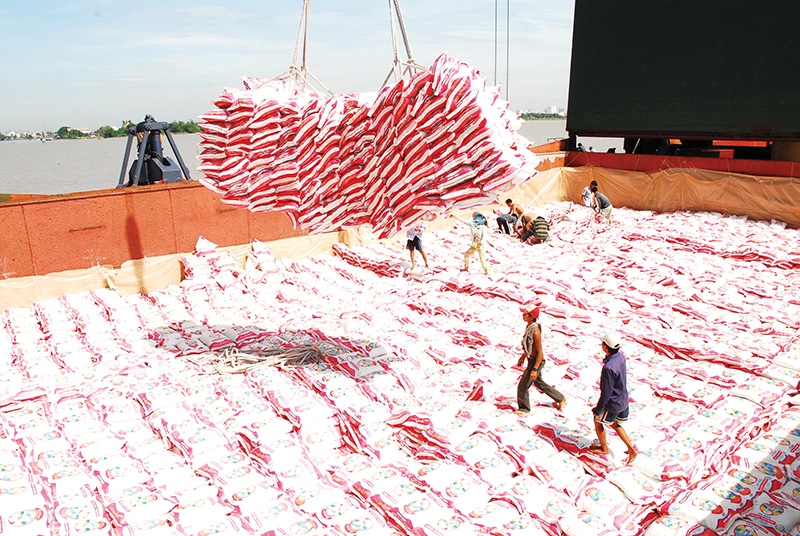Rice stocks not a cause for concern
 |
| Rice will continue to remain a strength in Vietnamese exports, Photo: Le Toan |
In Document No.2237/BCT-XNK, the Ministry of Industry and Trade (MoIT) proposed to the prime minister at the end of last week showed that after satisfying domestic consumption needs and reservation, Vietnam would still have around 13.5 million tonnes of rice, which would make 6.5-6.7 million tonnes of milled rice to export. The country could export three million tonnes of milled rice from the winter-spring crop during November-April.
The calculations in the document were based on the production and consumption plans of the Ministry of Agriculture and Rural Development. Accordingly, in 2020, Vietnam’s rice output is estimated at 43.5 million tonnes. Meanwhile, the domestic demand, including reservation, is 29.96 million tonnes. Some 14.26 million tonnes of this would go for consumption, 7.5 million tonnes for processing, 3.4 million tonnes for feeding animals, one million tonnes for breeding, and 3.8 million tonnes for reservation.
For the winter-spring crop, the area damaged by drought and salt intrusion is negligible. After deducting the amounts needed for storage and consumption, the volume of rice for export is about three million tonnes. Based on the data, after careful calculations to ensure food security, the MoIT proposed to allow rice exports subject to a monthly quota. In April and May, the 2020 purchase plan of the General Department of State Reserves will require about 300,000 tonnes of rice while an additional 400,000 tonnes would be required for backup. Thus, the amount of exported rice retained for domestic demand in the two months is 700,000 tonnes while the estimated export volume is about 800,000 tonnes. Therefore in April, 400,000 tonnes of rice would be allowed to be exported.
At last week’s government meeting on food security, Prime Minister Nguyen Xuan Phuc agreed with the suggestion of controlled
rice exports. “The good winter-spring crop has been a boon to rice farmers, thanks to planting one month earlier to avoid the harsh weather. Rice export remains a strength of Vietnam, but in the context of the pandemic, it is necessary to make some adjustments to ensure food security for our 100 million people,” he said.
Vu Kim Hanh, CEO of the Business Studies and Assistance Centre, said that ensuring food security is important, but she urged the government to consider this issue on a longer time-scale of five or 10 years.
“According to a survey on Vietnamese people’s food needs, nearly 20 per cent of respondents use products made from rice. Besides, there are huge amounts of rice stored in the stocks of private companies,” she said.
Pham Thai Binh, general director of Trung An Hi-tech Farming JSC said that in two months, farmers in the Mekong Delta region will harvest the next summer-autumn crop lasting from April to August, while currently the rice reserves of enterprises are quite big already. “However, to ensure food security, businesses will follow the directions of the government,” Binh said.
Meanwhile, Huynh Thanh Ngan, founder of Hapi Agricultural Organic Trading and Production Co., Ltd., told VIR that while the volume of rice left for export is still quite large, there are far fewer export contracts. “Vietnam does not have to worry about a food shortage,” she said and also suggested that restrictions should not apply to organic rice because this goods category is in little demand in the domestic market.
According to the Vietnam Food Association, its 92 members contribute about 75 per cent of the nation’s total rice exports. By March 27, the association had contracts to deliver a total of 1.574 million tonnes of rice, 1.385 million tonnes of which are due by May 31. There are currently 1.651 million tonnes of rice in their stores.
Deputy Minister of Industry and Trade Tran Quoc Khanh told VIR that the ministry has prepared for all scenarios. “Vietnam’s rice crop harvest is due in a short time. Our stocks can recover to meet the needs of the people and businesses alike. If the pandemic is prolonged, the national food security will still be ensured,” Khanh said.What the stars mean:
★ Poor ★ ★ Promising ★★★ Good ★★★★ Very good ★★★★★ Exceptional
Related Contents
Latest News
More News
- Protect what’s next: towards a future free from meningococcal group B disease (December 05, 2025 | 18:00)
- New ILO report offers policy recommendations for disability inclusion (December 04, 2025 | 15:18)
- Maternal job loss may affect children’s mental health, research shows (December 03, 2025 | 19:11)
- Women lead Vietnam’s shift to climate-resilient agriculture (December 03, 2025 | 19:10)
- Experts highlight unpaid care work as key barrier to gender equality (December 03, 2025 | 15:15)
- Opportunities and inequalities for women workers in Vietnam's garment industry (December 03, 2025 | 09:00)
- Vietjet flights carry love to devastated central region (November 28, 2025 | 11:35)
- New initiative to boost the fight against domestic violence (November 26, 2025 | 10:00)
- South Korea funds IOM relief for Vietnam’s typhoon-affected communities (November 24, 2025 | 15:33)
- AI and human-centred values set to shape the future of HR in Vietnam (November 21, 2025 | 18:04)

 Tag:
Tag:






















 Mobile Version
Mobile Version